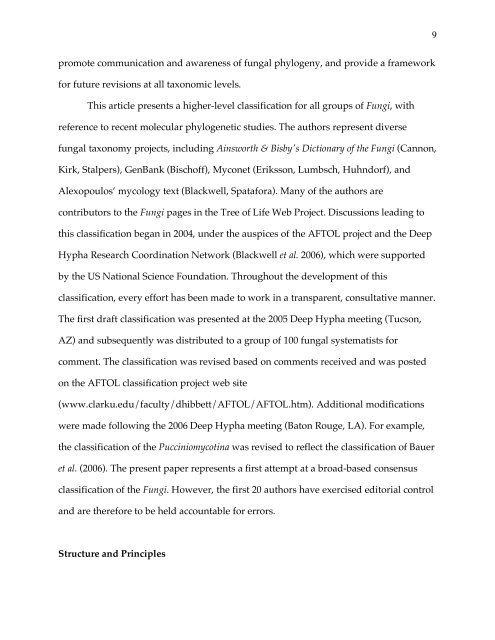Elsevier Editorial System(tm) for Mycological ... - Clark University
Elsevier Editorial System(tm) for Mycological ... - Clark University
Elsevier Editorial System(tm) for Mycological ... - Clark University
Create successful ePaper yourself
Turn your PDF publications into a flip-book with our unique Google optimized e-Paper software.
promote communication and awareness of fungal phylogeny, and provide a framework<br />
<strong>for</strong> future revisions at all taxonomic levels.<br />
This article presents a higher-level classification <strong>for</strong> all groups of Fungi, with<br />
reference to recent molecular phylogenetic studies. The authors represent diverse<br />
fungal taxonomy projects, including Ainsworth & Bisby's Dictionary of the Fungi (Cannon,<br />
Kirk, Stalpers), GenBank (Bischoff), Myconet (Eriksson, Lumbsch, Huhndorf), and<br />
Alexopoulos’ mycology text (Blackwell, Spata<strong>for</strong>a). Many of the authors are<br />
contributors to the Fungi pages in the Tree of Life Web Project. Discussions leading to<br />
this classification began in 2004, under the auspices of the AFTOL project and the Deep<br />
Hypha Research Coordination Network (Blackwell et al. 2006), which were supported<br />
by the US National Science Foundation. Throughout the development of this<br />
classification, every ef<strong>for</strong>t has been made to work in a transparent, consultative manner.<br />
The first draft classification was presented at the 2005 Deep Hypha meeting (Tucson,<br />
AZ) and subsequently was distributed to a group of 100 fungal systematists <strong>for</strong><br />
comment. The classification was revised based on comments received and was posted<br />
on the AFTOL classification project web site<br />
(www.clarku.edu/faculty/dhibbett/AFTOL/AFTOL.h<strong>tm</strong>). Additional modifications<br />
were made following the 2006 Deep Hypha meeting (Baton Rouge, LA). For example,<br />
the classification of the Pucciniomycotina was revised to reflect the classification of Bauer<br />
et al. (2006). The present paper represents a first attempt at a broad-based consensus<br />
classification of the Fungi. However, the first 20 authors have exercised editorial control<br />
and are there<strong>for</strong>e to be held accountable <strong>for</strong> errors.<br />
Structure and Principles<br />
9
















